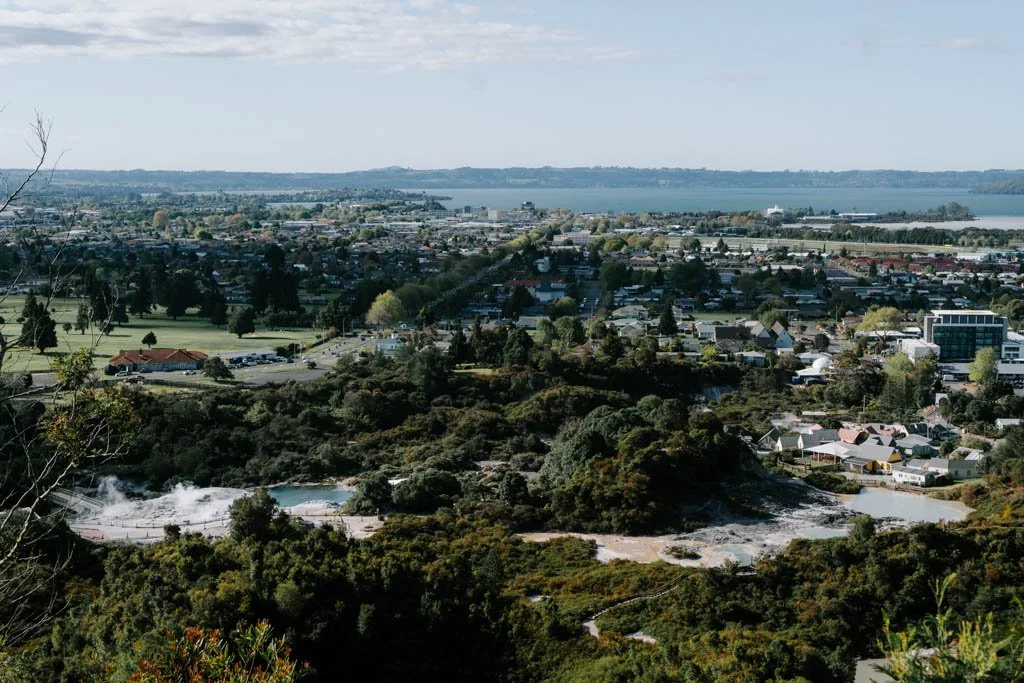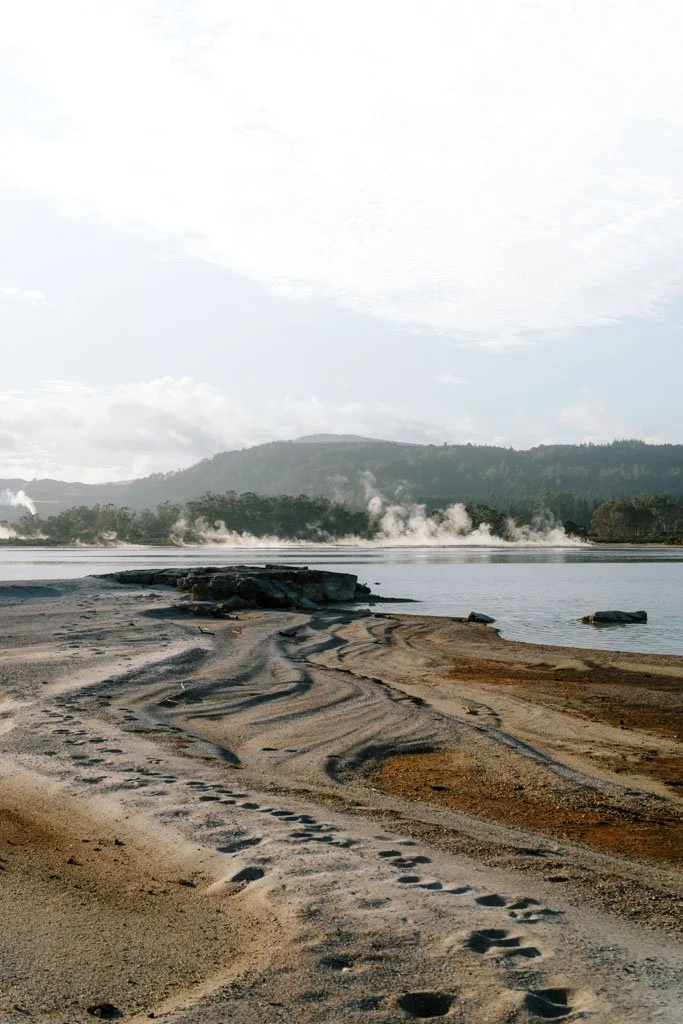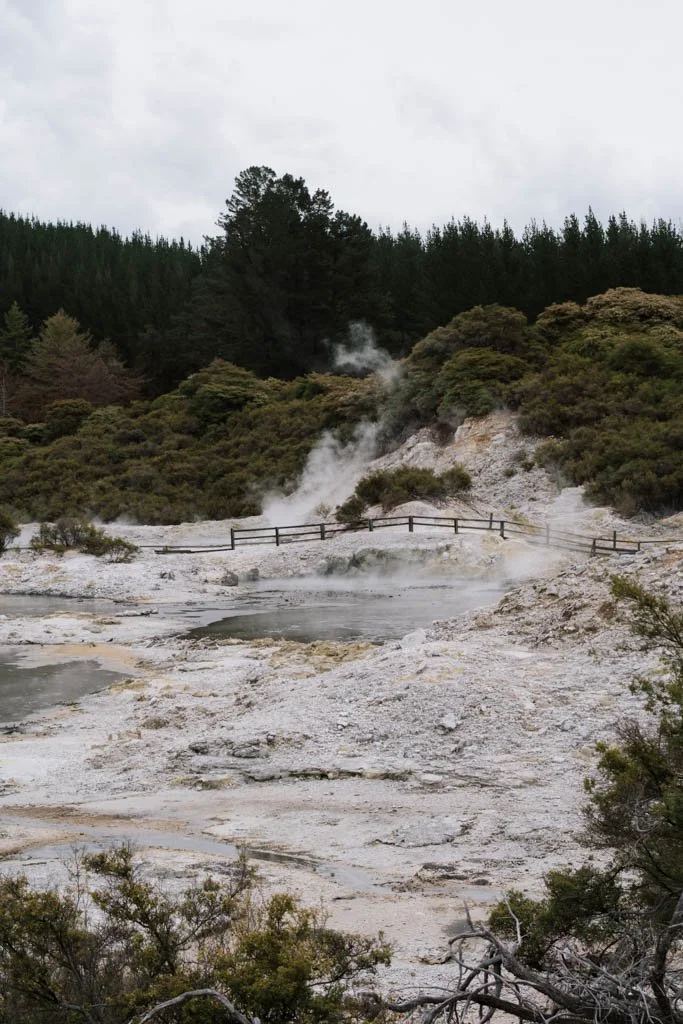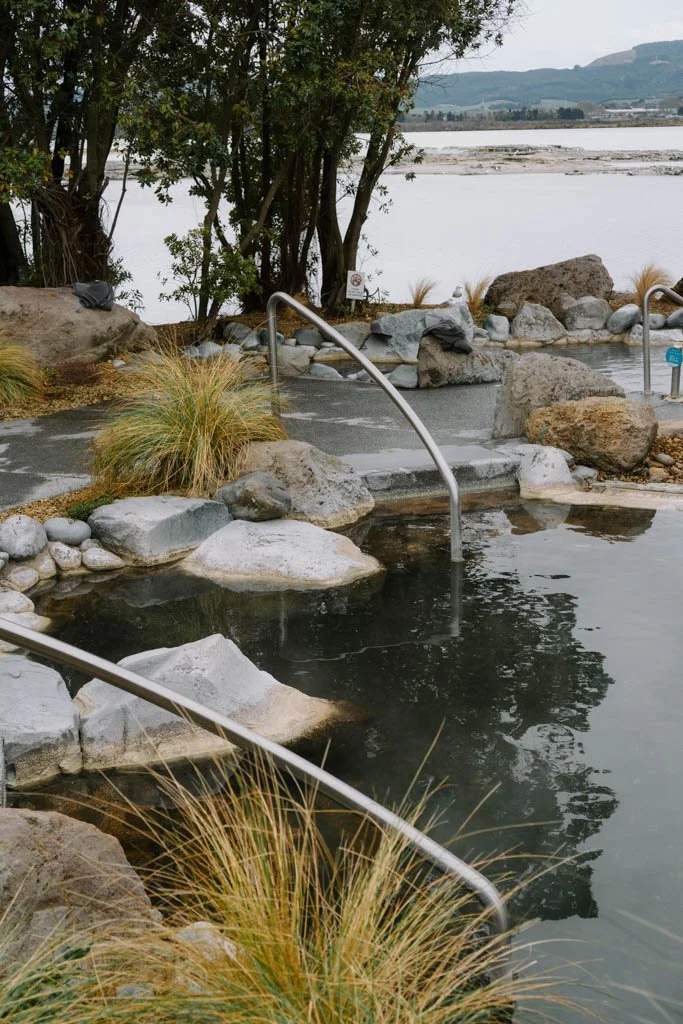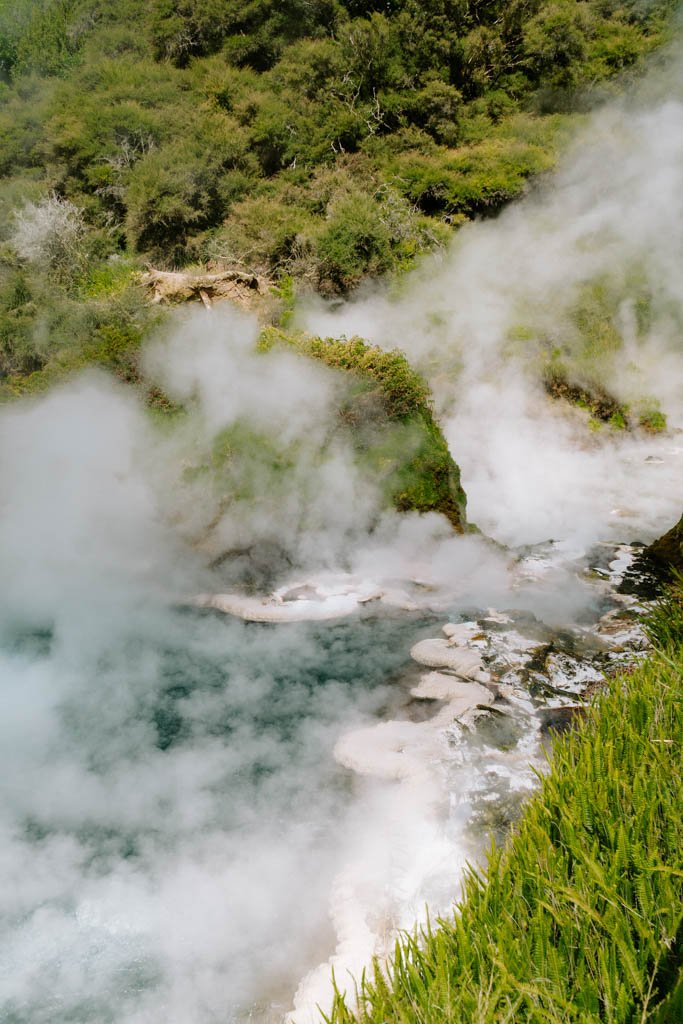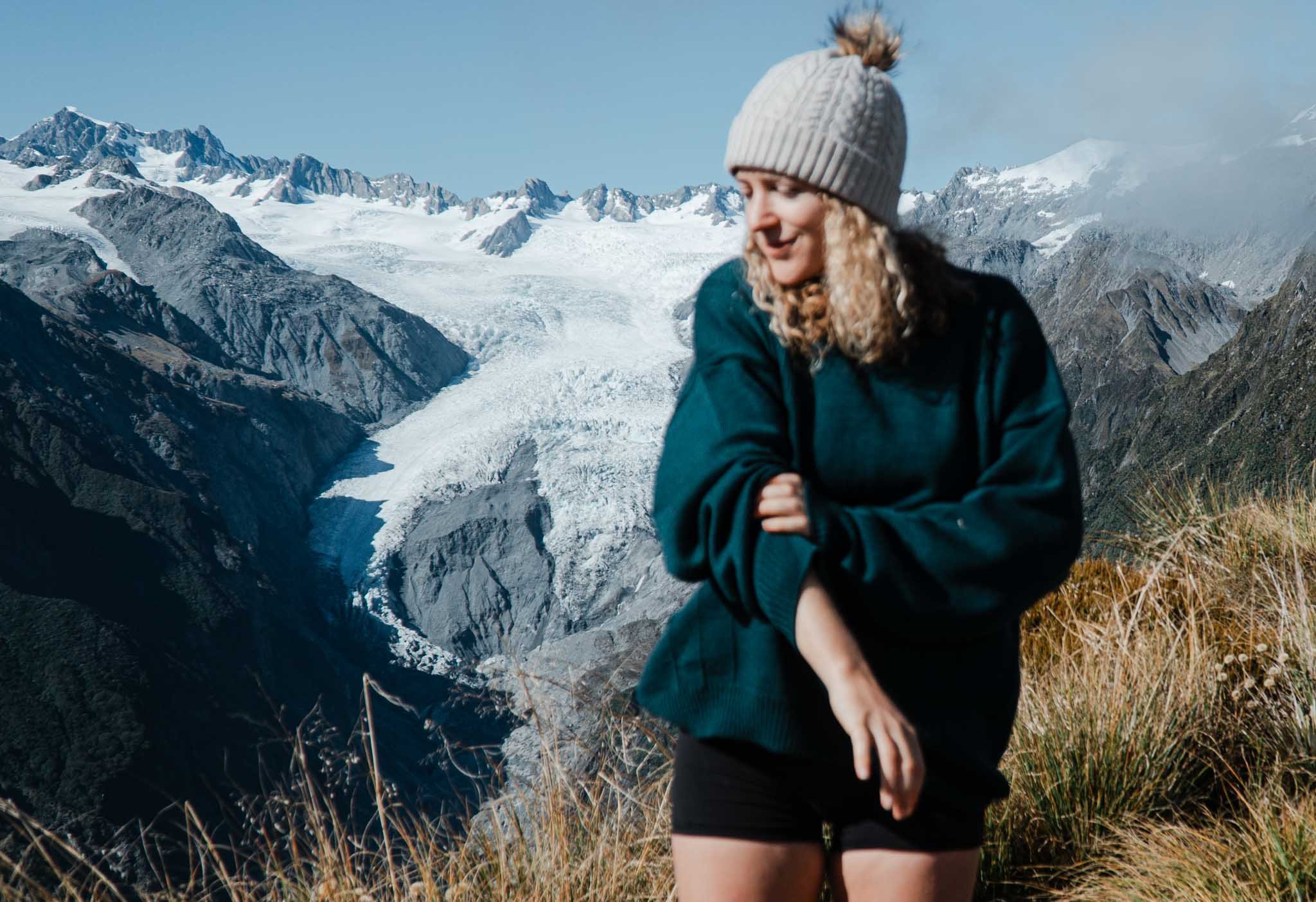A local’s guide to Rotorua’s best geothermal parks and pools
Where to go if you want to find a balance of natural wonder and serenity in Rotorua (according to someone who lives there).
Geothermal areas right next to the centre of Rotorua
Disclosure: This post contains affiliate links, which means I may earn a small commission if you book through those links. I appreciate your support!
Visitors have been flocking to Rotorua’s thermal waters and volcanic wonders since the 1870s. Back then, many came to see the Pink and White terraces of silica deposits, which were destroyed in the 1886 Mt Tarawera eruption.
The fabled terraces may be gone, but there are still plenty of natural wonders luring visitors to Rotorua.
Steam rising from the lake shore in Rotorua
Your first introduction to New Zealand’s most dynamic thermal area is likely to be a whiff of sulphur-rich air as you drive into town. Rotorua is built right on top of a geothermal system which sends steam up through storm drains, and makes mud bubble in public parks. One of the main reasons to visit Rotorua is to see a geyser, a colourful pool of acid, or steaming cliffs.
Each of the geothermal parks in Rotorua offers something slightly different; whether that is combining the geothermal sights with hangi food cooked in the ground, a mud bath, or a soak in soothing hot waters.
I recently moved to Rotorua, and have gradually been making my way around all of the geothermal pools and parks in the area. This is my take, as a local, on the best geothermal activities in Rotorua.
At a glance — Rotorua’s best geothermal parks and hot pools
Waimangu Volcanic Valley has the best range of geothermal features
Orakei Korako is the best off the beaten track option
Hell’s Gate is the only geothermal park where you can also opt for a mud bath
Te Puia is the ideal option if you want to combine geothermal highlights with Maori culture, in one visit
Kuirau Park, in the centre of Rotorua, is free to walk around and features steaming pools and even thermal foot baths
Kuirau Park, lying just to the west of Rotorua’s town centre, is an easy and affordable place to start exploring geothermal sights. The park itself isn’t the most scenic, but it features steaming hot pools, boiling mud, and free thermal foot baths.
Sulphur Point
Walking to Sulphur Point on Rotorua’s lakefront, at sunrise
Steam rising in the early morning sunrise, right on the lakefront in Rotorua
Sulphur Point, on the lakefront, gives you the chance to walk right alongside steam vents and mud pools. Start near the Polynesian Spa on Hatupatu Drive and follow the lake.
Waimangu Volcanic Valley
The Inferno Crater at Waimangu Volcanic Valley is mostly hidden behind a curtain of steam
When the Mt Tarawera eruption in 1886 destroyed the Pink and White Terraces, it created this thermal area (the terraces are thought to be beneath the waters of Lake Rotomahana in the Waimangu reserve).
The steaming shore of Frying Pan Lake
A quieter option than Wai O Tapu, Waimangu is explored via a gentle downhill walk of 1-2 hours through the valley.
Along the way are thermal and volcanic features like Frying Pan Lake, a vast hot spring, and Inferno Crater Lake, which has pastel blue water in the right conditions (the intensity of the colour depends on the water level, which rises and falls in a 38 day cycle, and how much you can see depends on the amount of steam blowing around), and colourful silica terraces.
The brightly coloured silica terraces at Waimangu Volcanic Valley
The walk concludes on the shore of Lake Rotormahana; you can opt for a boat trip on the lake, for a closer look at steaming cliffs, or catch a shuttle back up the hill to the beginning.
Wai O Tapu
The Champagne Pool at Wai O Tapu
Wai O Tapu, around 30 minutes south of Rotorua on the road towards Taupo, is mostly famous for the Champagne Pool, a well of boiling geothermal liquid about 65 metres across.
The rim of the pool is bright orange, while the steaming water is a gorgeous deep green.
Other features at Wai O Tapu include bright green pools and the Lady Knox Geyser, which is nudged to erupt every day at 10.15am with the help of organic soap.
If you’re not interested in the geyser (and there are other, naturally erupting ones to be seen elsewhere) try to avoid visiting Wai O Tapu in the mid morning, as the crowds gathered to Lady Knox blow then all shuffle into the park.
The crowds, of course, are the main downside to visiting Wai O Tapu. The park is not large, so unlike Waimangu, visitors aren’t as dispersed. With the beautifully photogenic Champagne Pool as a drawcard, Wai O Tapu is the busiest of Rotorua’s geothermal parks (at least, it feels that way).
The bright green lake at Wai o Tapu
Also worth noting is that one spectacular feature of the Wai O Tapu geothermal area is free to visit. Located a few minutes from the park is the Wai O Tapu mud pool, the largest mud pool in New Zealand, located right by the road. Even if you opt to visit another geothermal park, it’s worth swinging by this impressive mud pool.
Te Puia
Rotorua’s most comprehensive geothermal reserve is Te Puia; along with bubbling mud pools and the mighty Pohutu Geyser (the largest and most active in the Southern Hemisphere, erupting up to 20 times a day), the park is home to the New Zealand Māori Arts and Crafts Institute, a kiwi conservation centre, and stand-out kapa haka (traditional Maori performing arts) performers.
In one visit, you can see geothermal activity, a Maori haka, kiwi birds, and stop for a traditional hangi meal afterwards.
It might not be the most visually interesting of Rotorua’s geothermal parks, and the structured approach might not be for everyone (all visitors are taken on a guided tour, instead of exploring at your own pace) but with such a wide offering, Te Puia makes for a great one stop shop.
Hell’s Gate
Hell’s Gate – which got its name thanks to playwright George Bernard Shaw, who declared “this could be the gates of hell” upon seeing the area's pits of boiling mud – claims to be Rotorua’s most active geothermal field.
Although less colourful than Waimangu or Wai O Tapu, the geothermal reserve does have an impressive and barren moonscape of simmering pools, sulphur formations, and mud volcanoes.
What makes Hell’s Gate truly unique, though, is that this is the only geothermal park or spa offering the chance to slather yourself in mud dug from pools around the reserve. Don’t let the ‘spa’ label fool you; this is a rustic experience, not a luxury one.
I enjoyed the chance to cover myself in mud (this isn’t something you get to do very often) but I appreciate that it might not be for everyone. Although the mud bath and spa experience includes bathing in hot pools (the mud bath is limited to 20 minutes) they are far from the best in Rotorua.
The cost of visiting the mud spa alone is $90; for $115, you can also explore the geothermal reserve.
With such a modest price difference, I recommend getting a combined ticket and enjoying a walk around the grounds (and if timing allows, join one of the free guided tours at 10.30am or 2.30pm). The mud spa alone would have felt too rushed otherwise, and I appreciated the size of the geothermal area at Hell’s Gate.
Pohaturoa Track to the Whaka Lookout
If you’re on a tight budget, or just fancy a walk, a great option is to follow the Pohaturoa track to the Whaka Lookout, which has views across both Te Puia and Whakarewarewa Village. Time it right, and you might even see the Pohutu Geyser erupt.
The walk starts and finishes (you can walk it as a loop, but I prefer out to the lookout and back the same way) right by Eastwood Cafe.
Orakei Korako
Orakei Korako doesn’t have the champagne pool, but it has plenty of colour and some pretty impressive silica terraces
Orakei Korako is closer to Taupo than Rotorua, and a fair distance from the main highway between the two towns (it’s around 50 minutes from Rotorua) but if you don’t mind the drive, it’s a lovely quiet spot.
Featuring the requisite colourful silica terraces, geysers, and bubbling hot springs, Orakei Korako mostly stands out for the sense of peace you’ll get there (it’s much quieter than the other parks). To reach the geothermal area, you also get the added bonus of a short ferry ride across a river
Once in the park, the walk only takes 1-2 hours.
The best thermal hot springs in Rotorua
All the geothermal activity beneath the surface means Rotorua has an abundance of hot springs. These range from hot rivers, lakefront hot pools, and rustic pools where the water is straight from the ground.
Skip the Secret Spot hot tubs (which are heated with electricity, instead of being fed with geothermal water) and soak in one of the area’s many naturally thermal pools.
Polynesian Spa
In terms of convenience, it’s hard to beat the Polynesian Spa, which is located on the lakefront right in the centre of Rotorua.
There are several pool options to choose from; the Pavilion Pools have a standard swimming pool aesthetic, but nice lake views.
The Deluxe Lake Spa has pools that are fringed with rocks, to make them appear more in tune with the natural environment, as well as towels, lockers, and a cold plunge pool, but the views are the same.
Ostensibly, some pools are alkaline and others acidic, but the only discernible difference for me was the variations in temperature.
With slightly dated facilities, the Polynesian Spa isn’t going to be the most luxurious thermal pool experience, but you can’t complain too much about soaking in hot water lakeside.
Waikite Valley
Te Manaroa Spring
These open air pools are a 30 minute drive south of Rotorua (but only 10 minutes from other attractions nearby, such as Wai O Tapu and Waimangu Valley) but they are worth the trek.
The hot pools are fed by the impressive Te Manaroa Spring, the largest single source of boiling water in New Zealand. Follow a short trail from the hot pool complex to see the roiling waters of the spring for yourself. Water from Te Manaroa flows continuously through the pools, with the only modification being to cool the water to different temperatures. Highlights are the Pergola and Garden pools, both surrounded by lush foliage and offering views of the valley beyond.
These pools are rarely busy and offer excellent value for money. There’s even a campground if you’d like to stay overnight and have exclusive access to the pools, before the rest of the public, first thing in the morning.
Rotorua’s free hot pools
Located around 30 minutes south of Rotorua, off the highway heading to Taupo, is Kerosene Creek. The hot stream is Rotorua’s most well-known spot for bathing in thermal water for free, but it’s far from the prettiest. To reach the stream, you’ll need to bump and rattle 2 kilometres down a potholed gravel road and park in an area known for vehicle break-ins (lock your car and keep valuables out of sight).
A short trail leads to the creek, through pine forest and bramble thickets. The path can be muddy and rubbish is not uncommon. If you make it past all of these obstacles, you’ll be rewarded with a soak in a pleasantly warm stream, which features several deeper pools and even a small waterfall. For a quieter pool, explore the areas a little upstream of the waterfall, which is where most people swim.
I prefer bathing in Hot and Cold, another hot stream a further 10 minutes south (right next to the Wai O Tapu geothermal area). Despite the fact these hot pools are more or less under a road bridge, and there is a sign warning that there could be syringes, condoms, and broken glass in the water, the water at Hot and Cold is much clearer than the brackish stream at Kerosene Creek, and feels hotter as well .
Most people like to sit at the confluence of the hot stream with a cold stream (hence the name) so you can alternate temperatures, but I prefer wading upstream to the quieter pools which have been deepened with unobtrusive rock landscaping.
Thanks for reading this far! I hope this helped you decide which geothermal park to visit in Rotorua.
AUTHOR BIO
I’m a freelance travel writer from New Zealand with bylines in National Geographic Travel, Conde Nast Traveler, Travel + Leisure and more.
I’ve travelled up and down beautiful Aotearoa and I love sharing my recommendations for the best places to visit in New Zealand.
This post was about:
READ MORE
